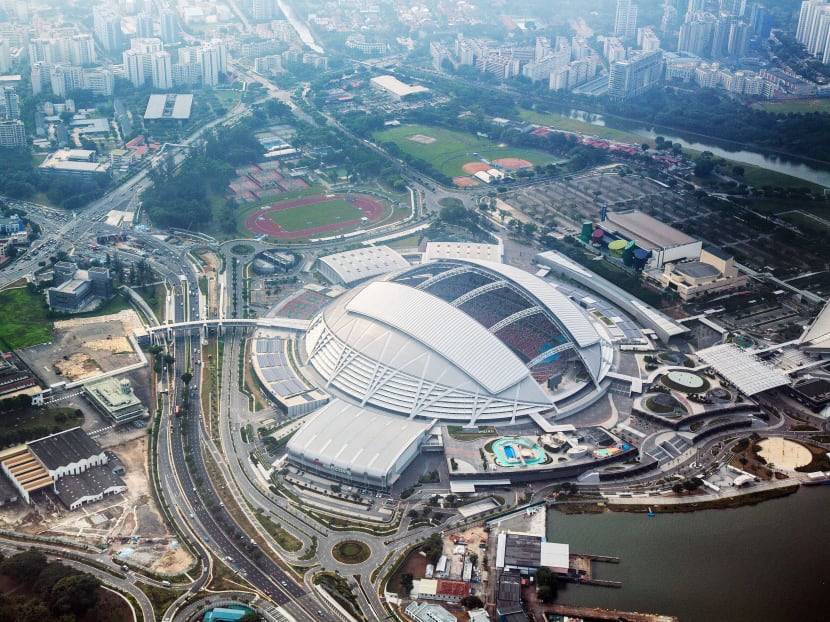Infrastructure Protection Bill passed in Parliament
SINGAPORE — Proposed laws to beef up protection of buildings that are iconic, highly frequented or that house essential services were passed yesterday, with Second Home Affairs Minister Josephine Teo saying the measures could cost 0.2 to 3 per cent of total construction cost.

Proposed laws to beef up protection of buildings that are iconic, highly frequented or that house essential services were passed yesterday, with Second Home Affairs Minister Josephine Teo saying the measures could cost 0.2 to 3 per cent of total construction cost. Photo: Bloomberg
SINGAPORE — Proposed laws to beef up protection of buildings that are iconic, highly frequented or that house essential services were passed yesterday, with Second Home Affairs Minister Josephine Teo saying the measures could cost 0.2 to 3 per cent of total construction cost.
The estimate is based on past projects but Mrs Teo said: “Not all of this cost is attributable to the design process per se, since all buildings have to be fitted with some security measures in any case.”
She was responding to questions during the parliamentary debate on the Infrastructure Protection Bill. Members of Parliament Melvin Yong (Tanjong Pagar GRC) and Desmond Choo (Tampines GRC) were concerned that building owners would pass the costs on to tenants and consumers.
Building owners and developers recognise that ensuring security is part and parcel of business, and know that damage to property in a terror attack could be much costlier, said Mrs Teo.
Integrating security into a building’s design can offer savings in the longer haul – closed circuit television (CCTV) and access-control systems could help save on manpower costs, for example.
The Bill requires new buildings to integrate security measures such as video surveillance, vehicle barriers and protection against blasts in their design before they are built, and for selected existing buildings to incorporate such measures in their renovation plans.
An example of critical infrastructure is Changi Airport, while the Sports Hub is an example of a large or iconic building.
There are several hundred such buildings here, most of which are critical infrastructure, said the ministry.
Only a “handful” of new developments are expected to be affected each year, and involve those with a gross floor area of over 100,000 sqm for a start, said Mrs Teo.
The specific criteria – such as the size, location and type of development – will be published in the Gazette.
Owners or occupiers of developments must submit a security plan to the authorities for approval before carrying out major contruction works. They could be fined up to S$200,000 and be jailed up to two years for failing to do so. A development may obtain a Temporary Occupation Permit or Certificate of Statutory Completion only after security measures are in place. A Commissioner of Infrastructure Protection -- a senior public servant from the Home Affairs Ministry -- will oversee the administration of the new laws.
The new law will allow the Government to direct building owners excluded from the “security-by-design” requirements to roll out appropriate security measures to guard against a terror attack. The authorities will give developers a reasonable timeframe to comply but if an attack is imminent, emergency orders may also be issued to protect the buildings, she said. But this will be done as a “last resort”.
The new laws will entail other changes: More training for security and auxiliary police officers, and engineers specialising in protective security, for which a new scheme will be launched next year by the Home Affairs Ministry and Professional Engineers Board.
Unauthorised photography of protected places or areas listed under the Protected Areas and Protected Places Act (PAPPA) – which was repealed under this Bill – is also an offence, unless the authority in charge of the space permits it.
Workers’ Party MP Sylvia Lim (Aljunied GRC) questioned why the maximum fines for offences were raised “drastically” from S$1,000 to S$20,000 under the new law. Ms Lim also asked if it was reasonable to punish those who snap pictures from outside a protected area or place.
Mrs Teo said authorised officers – who will be trained to exercise their new powers and carry a map displaying a specific area – will exercise discretion. The police will develop rules of engagement on how these powers are to be used.
If photos are taken inadvertently, they will typically warn individuals and ask them to delete the images. Further action will be taken if warranted, or if the individual does not comply. The fine of S$1,000, under the PAPPA, had not been amended since 1959, she said.
Tanjong Pagar MP Joan Pereira called for hospitals to be considered protected areas. Mrs Teo said her ministry works closely with the Health Ministry on security at hospitals, such as building security and police patrols. Each hospital also has preventive measures and contingency plans for scenarios including terrorist incidents.
Earlier this year, the Public Order Act was also amended to require organisers of events with large crowds and those that are of higher risk to put in place security measures.








